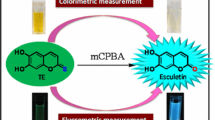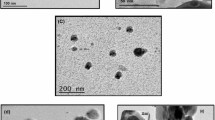Abstract
The chemistry of thiol-chromophore linkage plays a central role in the nature of fluorescence of phycoerythrin (PE). Interaction of thiol and chromophore is crucial for the energy transfer, redox signal and inhibition of oxidative damage. In the present investigation the effects of ultraviolet-B radiation on an emission fluorescence intensity and wavelength shift in PE due to interaction between thiol and chromophore by remarkable strategy of detection technique was studied. Purification of PE was done by using a gel permeation and ion exchange chromatography that yielded a quite high purity index (6.40) in a monomeric (αβ) form. UV-B radiation accelerated the quenching efficiency (24.9 ± 1.52%) by reducing fluorescence emission intensity of thiol linked chromophore after 240 min of UV-B exposure. However, after blocking of transiently released free thiol by N-ethylmaleimide, quenching efficiency was increased (36.8 ± 2.80%) with marked emission wavelength shift towards shorter wavelengths up to 562 nm as compared to 575 nm in control. Emission fluorescence of free thiol was at maximum after 240 min that was detected specifically by monobromobimane (mBrB) molecular probe. The association/dissociation of bilin chromophore was analyzed by SDS- and Native-PAGE that also indicated a complete reduction in emission fluorescence. Our work clearly shows an early detection of free thiols and relative interaction with chromophore after UV-B radiation which might play a significant role in structural and functional integrity of terminal PE.




Similar content being viewed by others
References
Häder D-P, Williamson CE, Wängberg S, Rautio M, Rose KC, Gao K, Helbling EW, Sinha RP, Worrest R (2015) Effects of UV radiation on aquatic ecosystems and interactions with other environmental factors. Photochem Photobiol Sci 14:108–126
Sinha RP, Hader D-P (2008) UV-protectants in cyanobacteria. Plant Sci 174:278–289
Manney GL, Santee ML, Rex M, Livesey NJ, Pitts MC et al (2011) Unprecedented Arctic ozone loss in 2011. Nature 478:469–475
Kannaujiya VK, Sinha RP (2015) Impacts of UV-B and PAR on phycobiliproteins of Nostoc sp. HKAR-2 and Nostoc sp. HKAR-11. Protoplasma 252:1551–1561
Richa, Kannaujiya VK, Kesheri M, Singh G, Sinha RP (2011) Biotechnological potentials of phycobiliproteins. Int J Pharm Bio Sci 2:446–454
Sinha RP, Lebert M, Kumar A, Kumar HD, Häder D-P (1995) Spectroscopic and biochemical analyses of UV effects on phycobiliproteins of Anabaena sp. and Nostoc carmium. Bot Acta 108:87–92
Sidler WA (1994) Phycobilisome and phycobiliprotein structures. In: Bryant DA (ed) The molecular biology of cyanobacteria. Kluwer Academic Publication, Netherlands, pp. 139–216
Baron M, Sochor J (2013) Estimation of thiol compounds cysteine and homocysteine in sources of protein by means of electrochemical techniques. Int J Electrochem Sci 8:11072–11086
Leichert LI, Jakob U (2004) Protein thiol modifications visualized in vivo. PLoS Biol 2:1723–1733
Vass I (2012) Molecular mechanisms of photodamage in the photosystem II complex. Biochim Biophys Acta 1817:209–217
Holzwarth AR, Bittersmann E, Reuter W, Wehrmeyert W (1990) Studies on chromophore coupling in isolated phycobiliproteins. III. Picosecond excited state kinetics and time-resolved fluorescence spectra of different allophycocyanins from Mastigocladus laminosus. Biophys J 57:133–145
Kupka M, Scheer H (2008) Unfolding of C-phycocyanin followed by loss of non-covalent chromophore-protein interactions 1. Equilibrium experiments. Biochim Biophys Acta 1777:94–103
Alvey RM, Biswas A, Schluchter WM, Bryant DA (2011) Attachment of noncognate chromophores to CpcA of Synechocystis sp. PCC 6803 and Synechococcus sp. PCC 7002 by heterologous expression in Escherichia coli. Biochemistry 7:4890–4902
Kannaujiya VK, Sinha RP (2016) Thermokinetic stability of phycocyanin and phycoerythrin in food-grade preservatives. J Appl Phycol 28:1063–1070
Soni B, Kalavadia B, Trivedi U, Madamwar D (2006) Extraction, purification and characterization of phycocyanin from Oscillatoria quadripunctulata-isolated from the rocky shores of bet-Dwarka, Gujarat, India. Process Biochem 41:2017–2023
Bryant DA, Guglielmi G, de Marsac TN, Castlets AM, Cohen-Bazire G (1979) The structure of cyanobacterial phycobilisomes: a model. Arch Microbiol 123:113–127
Kannaujiya VK, Sinha RP (2016) An efficient method for the separation and purification of phycobiliproteins from a rice-field cyanobacterium Nostoc sp. strain HKAR-11. Chromatographia 79:335–343
Wang Y, Gong X, Wang S, Lixue C, Sun L (2014) Separation of native allophycocyanin and R-phycocyanin from marine red macroalga Polysiphonia urceolata by the polyacrylamide gel electrophoresis performed in novel buffer systems. PLoS One 9:e106369
Brekelman TR, Lagarias JC (1986) Visualization of Bilin linked peptides and proteins in polyacrylamide gels. Anal Biochem 156:194–201
Patsoukis N, Georgiou CD (2005) Fluorometric determination of thiol redox state. Anal Bioanal Chem 383:923–929
Chowdhury A, Mukherjee PS (2015) Electron-rich triphenylamine-based sensors for picric acid detection. J Org Chem 80:4064–4075
Hannoush RN, Sun JL (2010) The chemical toolbox for monitoring protein fatty acylation and prenylation. Nat Chem Biol 6:498–506
Trivedi MV, Laurence JS, Siahaan TJ (2009) The role of thiols and disulfides in protein chemical and physical stability. Curr Protein Pept Sci 10:614–625
Winther JR, Thorpe C (2014) Quantification of thiols and disulfides. Biochim Biophys Acta 1840:838–846
Kosower NS, Kosower EM, Newton GL, Ranney HM (1979) Bimane fluorescent labels: labeling of normal human red cells under physiological conditions. Proc Natl Acad Sci U S A 76:3382–3386
Fahey RC, Newton GL (1987) Determination of low-molecular-weight thiols using monobromobimane fluorescent labeling and high-performance liquid chromatography. Methods Enzymol 143:85–96
Pospíšil P (2009) Production of reactive oxygen species by photosystem II. Biochim Biophys Acta 1787:1151–1160
Rastogi RP, Singh SP, Häder D-P, Sinha RP (2010) Detection of reactive oxygen species (ROS) by the oxidant-sensing probe 2′-7′-dichlorodihydrofluorescein diacetate in the cyanobacterium Anabaena variabilis PCC 7937. Biochem Biophys Res Commun 397:603–607
Rinalducci S, Pedersen JZ, Zolla L (2008) Generation of reactive oxygen species upon strong visible light irradiation of isolated phycobilisomes from Synechocystis PCC 6803. Biochim Biophys Acta 1777:417–424
Munier M, Jubeau S, Wijaya A, Morançais M, Dumay J, Marchal L, Jaouen P, Fleurence J (2014) Physicochemical factors affecting the stability of two pigments: R-phycoerythrin of Grateloupia turuturu and B-phycoerythrin of Porphyridium cruentum. Food Chem 150:400–407
Rastogi RP, Sonani RR, Madamwar D (2015) Effects of PAR and UV radiation on the structural and functional integrity of phycocyanin, phycoerythrin and allophycocyanin isolated from the marine cyanobacterium Lyngbya sp. A09DM. Photochem Photobiol 91:837–844
Schmidt M, Krasselt A, Reuter W (2006) Local protein flexibility as a prerequisite for reversible chromophore isomerization in alpha-phycoerythrocyanin. Biochim Biophys Acta 1764:55–62
Rudyk O, Eaton P (2014) Biochemical methods for monitoring protein thiol redox states in biological systems. Redox Biol 2:803–813
Acknowledgement
V K Kannaujiya is thankful to the Council of Scientific and Industrial Research (CSIR), New Delhi, India (09/013(0258)/2009-EMR-I), for financial assistance in the form of senior research fellowship.
Author information
Authors and Affiliations
Corresponding author
Ethics declarations
Conflict of Interest
None.
Rights and permissions
About this article
Cite this article
Kannaujiya, V.K., Sinha, R.P. Detection of Free Thiols and Fluorescence Response of Phycoerythrin Chromophore after Ultraviolet-B Radiation Stress. J Fluoresc 27, 561–567 (2017). https://doi.org/10.1007/s10895-016-1983-0
Received:
Accepted:
Published:
Issue Date:
DOI: https://doi.org/10.1007/s10895-016-1983-0




